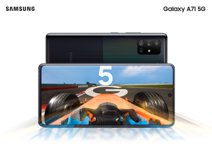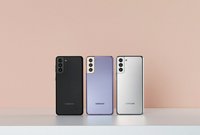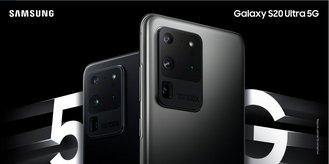Samsung Galaxy S20 Ultra Smartphone
MSRP 1359 EUR82% External
Product Gallery









Product Overview
Galaxy S20 Ultra is the ultimate Android smartphone by Samsung. Equipped with 5G, the Galaxy S20 Ultra supports both sub-6 and mmWave. It sports a 108MP camera for the ultimate stills and videos performance.
Ratings
What we found**
Pros
- Excellent performance
- Great battery life
- Great camera
- Great call quality
Cons
- Nothing in particular
What external reviewers found***
External score 82% (not directly comparable across industries)
Pros
- Fantastic image quality
- Fantastic 120 Hz screen
- Fantastic 120Hz display
- Excellent performance
Cons
- Unreliable autofocus
- Poor image processing
- Slow SoC
- Lacklustre low-light camera performance
- Mediocre speakers
- No 5G support
Price Comparison
Specifications
Connectivity
Wireless Connectivity
WiFi, Bluetooth 5.0, NFC, MST
Construction
Battery | Capacity
5000 mAh
Camera | Front
40MP f/2.2 PDAF
Camera | Rear
12MP f/2.2 (Ultra-Wide), 108MP f/1.8 PDAF, OIS (Wide), 48MP f/3.5 PDAF OIS, DepthVision
Dimensions
Size | Depth
8.8 mm
Size | Height
166.9 mm
Size | Width
76.0 mm
Weight
220 g
Display
Display Diagonal
6.9"
Display Type
Dynamic AMOLED
Refresh Rate
120 Hz
Resolution
3200 x 1440
Function
Chipset
7nm 64-bit Octa-Core Processor
GPS
GPS
SIM
1x or 2x Nano SIM
Wireless Charging
Fast Wireless Charging 2.0
Performance
Memory | Capacity
16 GB
Sample Rate
120 Hz
Storage
128, 256, 512 GB
Production
Debut
2020-02-12
Related Products

Samsung Galaxy Z Flip 5G Foldable Smartphone
72% External
Samsung Galaxy Z Flip 5G pairs the lightning-fast speeds of 5G with the company's statement-making Galaxy Z Flip. Now with 5G, the Galaxy Z Flip 5G brings blazing-fast speeds to the palm-sized foldable device, making it easier than ever to stay con...

Samsung Galaxy Z Fold2 Foldable Smartphone
77% External
Samsung Galaxy Z Fold2 is the company's second-generation flagship foldable smartphone. Packed with all the refinements and innovations that Samsung has to offer, the Galaxy Z Fold2 features a larger Cover Screen and massive Main Screen. The 6.2-in...

Samsung Galaxy S21 Ultra 5G Smartphone
86% External
Samsung Galaxy S21 Ultra is a flagship 5G smartphone that features a 5nm octa-core processors, Dynamic AMOLED 2X display, and four rear-facing cameras. It shares much of the same features with the S21+, including the height and width, but the S21 Ultra...

Samsung Galaxy Note20 Ultra 5G Smartphone
88% External
Samsung Galaxy Note20 Ultra is the flagship smartphone in Samsung's late-2020 Galaxy lineup. Compared to the base Note20, it adds a larger, 6.9-inch QHD+ display with 120Hz refresh rate, 12GB LPDDR5 memory, and 4500mAh battery. For the first time in th...

Samsung Galaxy Z Fold3 5G Foldable Smartphone (2021)
76% External
Samsung Galaxy Z Fold3 is the company's third-generation flagship foldable smartphone. It is marginally smaller than its predecessor from 2020, while retaining the same general design. While displays of similar sizes (at 7.6" and 6.2" respe...

Samsung Galaxy A51 5G Smartphone
58% External
Galaxy A51 5G is one of a pair of the first smartphones in the Galaxy A series with 5G connectivity. It sports a large 6.5-in Super AMOLED Infitinity-O display, four cameras, and a long-lasting battery, among other industry-leading features.

Samsung Galaxy A71 5G Smartphone
68% External
Galaxy A71 5G is one of a pair of the first smartphones in the Galaxy A series with 5G connectivity. It sports a large 6.7-in Super AMOLED Infitinity-O display, four cameras, and a long-lasting battery, among other industry-leading features.

Samsung Galaxy Note20 Smartphone
74% External
Samsung Galaxy Note20 is part of Samsung's late-2020 flagship Galaxy Note-series "phablet" smartphones. It comes with 4300mAh battery, tri-camera setup, and a gorgeous Infinity-O OLED display. This time, deeper relationship with Samsung’s l...

Samsung Galaxy S20 FE (5G) Smartphones
86% External
Samsung Galaxy S20 FE (Fan Edition) is a flagship-level smartphone at a more accessible price point. It packs features of the Galaxy S20 series, such as 120Hz FHD+ Super AMOLED display, AI-powered camera, advanced chipset, WiFi 6 support, and all day b...

Samsung Galaxy S21 5G Smartphone
81% External
Samsung Galaxy S21 is a high-end 5G smartphone that features a 5nm octa-core processors, Dynamic AMOLED 2X display, and three rear-facing cameras. Compared to the Galaxy S20 from 2020, the Galaxy S21 removes the micro-SD card slot and reduces the resol...

Samsung Galaxy S21 Plus 5G Smartphone
83% External
Samsung Galaxy S21+ is a high-end 5G smartphone that features a 5nm octa-core processors, Dynamic AMOLED 2X display, and three rear-facing cameras. It shares much of the same features with the S21, but the S21+ comes with a bigger battery and a larger ...

Samsung Galaxy A52 (5G) Smartphone
69% External
Samsung Galaxy A52 is an affordable alternative to the South Korean company's 2021 Galaxy S21: Fronted with a 6.5-inch FHD+ OLED display, the A52 has a design similar to that of the S21 / S21 Plus, trading compromises with additional features. In terms...
Launch Comparison
Clear List
Related Articles

Samsung's 108-Megapixel ISOCELL Bright HM1 Sensor with Nonacell Technology Debuts with Flagship Galaxy S20 Ultra Smartphone
Samsung's new 108-megapixel ISOCELL Bright HM1 sensor uses Nonacell technology and debuts with the flagship Galaxy S20 Ultra smartphone.
News · 12 May 2020
3rd-Party Review Videos





External Reviews
ndtv[1]
Reviewer score 95%The Galaxy S20 Ultra is one of the best devices that Samsung has put out yet. The camera system on the device is excellent, and you are going to get a good shot pretty much irrespective of lighting conditions. Video recording maxes out at 8K for the primary camera and 4K 60fps for the selfie shooter. It packs in top-notch performance, but also warms up under load. The phone is a bit too bulky for comfortable day-to-day use.
Find the original article here.
Pros
- Top-notch performance
- Excellent battery life
- Excellent camera performance
- Fast charging
Cons
- Lacklustre low-light camera performance
anandtech[2]
Reviewer score 94%The Galaxy S20 Ultra is the single fastest, most responsive, and most fluid phone I’ve had the pleasure to use, quite far ahead of any second contender. The combination of a 120Hz screen with the new Snapdragon 865 is a match made in heaven. There’s still a lot of work to do until we get the full review finished, notably still waiting on the Exynos variants.
Find the original article here.
Pros
- Fantastic 120Hz display
- Fast SoC
- Excellent battery life
Cons
- No 120Hz mode
- Slow SoC
androidauthority[3]
Reviewer score 77%One year from launch and the Galaxy S20 Ultra is actually a better 5G phone than it was initially. US wireless networks have expanded their support for sub-6GHz-flavored 5G. It's a good camera phone, but not a great one. The biggest issue is that it's still notoriously slow to focus, and focus is a touch soft.
Find the original article here.
Pros
- Great battery life
- Excellent performance
- Great camera
Cons
- Camera is still a bit slow
- Camera software still needs work
digitaltrends[4]
Reviewer score 94%Samsung's Galaxy S20 Ultra is almost everything you could ask for in a high-end smartphone. With 128, 256, or 512GB GB storage and 12 or 16 GB RAM, you'll not want for anything while gaming, multitasking, or using the Ultra in your day-to-day. Top that off with 5G support for all the major U.S. networks, and you have an entertainment and work powerhouse.
Find the original article here.
Pros
- Beautiful 120Hz display
- Fantastic battery life
- Excellent cameras
Cons
- No IP68 water resistance
- No wireless charging
gsmarena[5]
Reviewer score 59%The Galaxy S20 Ultra has a very capable camera system, both front and back. It has an amazing image quality before you factor in ghost touches and the inability to run 120Hz at the max resolution. Live focus (aka Portrait mode) is good most of the time, even if sometimes it does go crazy with misinterpreting what's going on in the bordering regions of subject separation. The screen is also among the biggest on anything that can reasonably be called a'mainstream' flagship smartphone.
Find the original article here.
Pros
- Gorgeous screen
- Bigger, better-than-average camera
- 120Hz refresh rate
- Great battery life
Cons
- No 120Hz at max resolution
- No wireless charging
nextpit[6]
Reviewer score 76%The fivefold optical zoom really makes composition a pleasure - and delivers really beautiful photos in good lighting conditions. Samsung does not give enough priority to exposing the faces in an ideal way, making them appear poorly lit in bright environments. The 100x zoom is a nice party gag and at best useful for reading the time at the church tower.
Find the original article here.
Pros
- Fantastic image quality
- Five-fold optical zoom
- Very good battery life
Cons
- No telephoto lens
- Poor image processing
- Unreliable autofocus
nextpit[7]
Reviewer score 91%Samsung has packed either 12 or 16GB of RAM into the S20 Ultra, depending on whether you choose a model with 128 or 256 or 512GB of storage space. In Europe and other selected markets, all S20 models are equipped with Samsung's own Exynos 990. In the USA, Qualcomm's Snapdragon 865 eight-core processor is used. Samsung has gone big on the camera this year and there are a lot of numbers to tackle.
Find the original article here.
Pros
- Beautiful 120Hz display
- Excellent battery life
- Excellent cameras
Cons
- No 5G
- No wireless charging
notebookcheck[8]
Reviewer score 71%The Samsung Galaxy S20 Ultra is a superb gaming device. Its Mali-G77 GPU performed significantly faster than its own predecessor. Only after extensive gaming sessions did we ever notice minor lags and stuttering. The two speakers make for a decent audio experience at medium volume. It supports dual audio and can play music on two connected devices.
Find the original article here.
Pros
- Bright 120 Hz display
- Good battery life
- Fast SoC
Cons
- Mediocre speakers
pcmag[9]
Reviewer score 58%, but focus still takes too long to lock. The camera lets you take photos before the focus has locked, which means trouble if you're too quick on the trigger. Samsung still needs work to catch up with Apple and Google on low-light performance. The Galaxy S20 Ultra is the first US phone to record 8K video.
Find the original article here.
Pros
- Big, bright screen
- Great battery life
- Good low-light performance
Cons
- Camera can take too long to lock
- Bulky and heavy
pcworld[10]
Reviewer score 97%There just aren't enough superlatives for how incredible the S20's display is. It reached an eye-piercing 1,350 nits with auto-brightness enabled. Samsung is using UFS 3.0 storage on all S20 models. Every handset is packed with at least 12GB of LPDDR5 memory.
Find the original article here.
Pros
- Fantastic 120Hz display
- Excellent battery life
- Excellent performance
Cons
- Not as fast as the S10e
- No wireless charging
techadvisor[11]
Reviewer score 64%The S20 Ultra is not a phone that most people should buy. It's too big for most people to afford, too ugly for the remaining few to ever want to show off its technical achievements. Still, at best it's capable of outclassing every competing flagship, even if it's maddeningly inconsistent and struggles in closeups. The 120Hz refresh rate is the crowning jewel to what might be the best phone right now.
Find the original article here.
Pros
- Gorgeous 120Hz display
- Great battery life
- Fast charging
Cons
- No 5G support
- Middling camera
techradar[12]
Reviewer score 96%-rate and zoom versatility – you get 20x video zoom in 4K, whereas you're stuck at 6x in 8K. You can also clip 33MP photos on the Galaxy S20 Ultra while recording, or in post if you're shooting 8K video. Samsung's One UI 2.0 software reskins Android 10 with a one-hand-friendly layout.
Find the original article here.
Pros
- Super-fast 5G
- Excellent battery life
- Excellent cameras
Cons
- No microSD card slot
- No wireless charging
theverge[13]
Reviewer score 78%The Galaxy S20 Ultra is a no expense spared, no stop un-pulled kind of phone. Samsung set out to show that it could outdo every other Android phone on the market. It's fast, powerful, beautiful, and has a battery that lasts. The main justification for that expense is the all-new camera system.
Find the original article here.
Pros
- Fast, powerful, and beautiful
- All-new camera system
- Long battery life
Cons
- No headphone jack
- No 5G support
tomsguide[14]
Reviewer score 83%On paper the Galaxy S21 Ultra seems like a clear winner. It has a hybrid zoom with 3x and 10 x optical lenses, support for Samsung's S Pen stylus, plus an extra year of Android and security updates. Samsung is also trying to build better experiences into the S20 line, starting with Google Duo integration. On top of Android 10, which includes new features like Smart Reply and enhanced privacy and notification controls.
Find the original article here.
Pros
- Gorgeous 120Hz display
- Great battery life
- Solid performance
Cons
- Camera could be better
- No 5G support
trustedreviews[15]
Reviewer score 90%The One UI 2.1 software on the S20 Ultra is one of the best you'll find. Customisability is key here, whether it’s changing how the phone performs while you’re gaming to how fast or high-res the screen is. DeX mode remains for allowing you to connect the phone to a Mac or PC to access info and apps from the phone. A new direct share function is a bit like AirDrop – letting you quickly send files, via Wi-Fi Direct, to other S20 devices.
Find the original article here.
Pros
- Beautiful 120Hz display
- Good battery life
- Good cameras
Cons
- No 5G support
- No dedicated button for Bixby
whathifi[16]
Reviewer score 93%The S20 Ultra has a massive 6.9in QHD+ AMOLED Infinity-O screen. Samsung claims it can capture three times more light than ever before. Wireless charging speeds are faster over the Galaxy S10 models, thanks to Fast Wireless Charging 2.0. The phone will be on sale from March 13th in Europe.
Find the original article here.
Pros
- Gorgeous AMOLED screen
- Great battery life
Cons
- Camera bump isn’t great
- No microSD card slot
wired[17]
Reviewer score 84%The S20 Ultra's camera is undoubtedly one of the most versatile available today. The presence of a 5G modem didn't enhance my everyday experience of using the phone. Don't buy this phone just because Samsung touts 8K or 5G. It's just not a good deal for the price of a good Android phone.
Find the original article here.
Pros
- Fantastic 120 Hz screen
- Excellent performance
- Excellent battery life
Cons
- Camera is inconsistent
- No microSD card slot
- No headphone jack
User Reviews
Comments
Please login before adding comments.
References
- ^ Samsung Galaxy S20 Ultra Review. [ndtv]. https://gadgets.ndtv.com/mobiles/reviews/samsung-galaxy-s20-ultra-review-price-india-108mp-camera-performance-2239924. 2020-06-03. Retrieved 2021-10-14.
- ^ Samsung Galaxy S20 Ultra (Snapdragon 865) Quick Performance Preview: Impressive. [anandtech]. https://www.anandtech.com/show/15609/samsung-galaxy-s20-ultra-snapdragon-865-quick-performance-preview. 2020-03-13. Retrieved 2021-03-22.
- ^ Samsung Galaxy S20 Ultra one year later: Is it still worth buying?. [androidauthority]. https://www.androidauthority.com/samsung-galaxy-s20-ultra-long-term-review-1206068/. 2021-03-13. Retrieved 2021-10-14.
- ^ Samsung Galaxy S20 Ultra review: Five months later, brains match brawn. [digitaltrends]. https://www.digitaltrends.com/cell-phone-reviews/samsung-galaxy-s20-ultra-review/. 2020-08-02. Retrieved 2021-03-22.
- ^ Samsung Galaxy S20 Ultra long-term review. [gsmarena]. https://www.gsmarena.com/samsung_galaxy_s20_ultra_long_term-review-2135p6.php. 2021-03-15. Retrieved 2021-10-14.
- ^ Samsung Galaxy S20 Ultra camera review: overwhelmed by new possibilities. [nextpit]. https://www.nextpit.com/samsung-galaxy-s20-ultra-camera-review. 2020-03-24. Retrieved 2021-03-22.
- ^ Samsung Galaxy S20 Ultra review: perfection exists only on paper. [nextpit]. https://www.nextpit.com/samsung-galaxy-s20-ultra-review. 2020-03-30. Retrieved 2021-03-22.
- ^ Samsung Galaxy S20 Ultra - High-End Smartphone Reeks of Poor Implementation. [notebookcheck]. https://www.notebookcheck.net/Samsung-Galaxy-S20-Ultra-High-End-Smartphone-Reeks-of-Poor-Implementation.459444.0.html. 2020-03-31. Retrieved 2021-03-22.
- ^ Samsung Galaxy S20 Ultra Review. [pcmag]. https://www.pcmag.com/reviews/samsung-galaxy-s20-ultra. 2020-03-27. Retrieved 2021-03-22.
- ^ Samsung Galaxy S20 Ultra review: Too much more for most. [pcworld]. https://www.pcworld.com/article/3530319/samsung-galaxy-s20-ultra-review.html. 2020-03-06. Retrieved 2021-10-14.
- ^ Samsung Galaxy S20 Ultra review. [techadvisor]. https://www.techadvisor.co.uk/review/samsung-galaxy-s20-ultra-3783348/. 2020-03-13. Retrieved 2021-03-22.
- ^ Samsung Galaxy S20 Ultra review. [techradar]. https://www.techradar.com/reviews/samsung-galaxy-s20-ultra-full-review. 2021-02-02. Retrieved 2021-03-22.
- ^ Samsung Galaxy S20 Ultra review: shutter bug. [theverge]. https://www.theverge.com/2020/2/27/21155012/samsung-galaxy-s20-ultra-review-5g-screen-camera-space-zoom-price. 2020-02-27. Retrieved 2021-03-22.
- ^ Samsung Galaxy S20 Ultra review. [tomsguide]. https://www.tomsguide.com/reviews/galaxy-s20-ultra. 2021-02-05. Retrieved 2021-03-22.
- ^ Samsung Galaxy S20 Ultra Review. [trustedreviews]. https://www.trustedreviews.com/reviews/samsung-galaxy-s20-ultra. Retrieved 2021-03-22.
- ^ Hands on: Samsung Galaxy S20 Ultra review. [whathifi]. https://www.whathifi.com/reviews/samsung-galaxy-s20-ultra. 2020-02-11. Retrieved 2021-03-22.
- ^ Review: Samsung Galaxy S20 Ultra. [wired]. https://www.wired.com/review/samsung-galaxy-s20-ultra/. 2020-02-28. Retrieved 2021-10-14.
The MSRP provided on this page may not apply to all regions equally. For the current price, please refer to the Price Comparison section.
This page contains affiliate links to third-party merchants such as Amazon, eBay, and Rakuten. When you make a purchase using the supplied links, we will receive a commission.
These key takeaways ("pros" and "cons") and summaries are identified from third-party reviews. They may differ from the original texts.
<
>
x